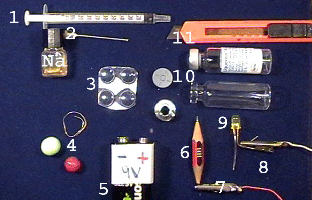Exploring
Red Sea Water re-using small packings = MicrEcol 1
M.
K. El-Marsafy, P.Schwarz
 MicrEcol
is a neologism describing a new experimental access to chemistry even for
children:
MicrEcol
is a neologism describing a new experimental access to chemistry even for
children:
The materials as well as
the quantities of matter needed are unusually small (micro):
Drops from syringes or dropper
bottles which are transferred to a plastic surface or into a small infusion
vial.
Small quantities mean less
raw materials, less waste, less money, less space, less time, less energy
and more safety.
So MicrEcol does not only
have didactic and economic advantages but also ecological
ones.
"What Johnny did not learn,
John will never learn": The target group of MicrEcol includes small children.
Even kids in Kindergarten
age can explore their environment by doing experiments with the water they
are drinking and the air they are breathing (Lück, 1997).

Materials and Chemicals
1: 1-ml syringe, 2:
blunt needle, 3: Blister packing with four cavities,
4: Beads and wire
to model a NaCl crystal lattice, 5: 9-Volt battery,
6: Pencil stub as
anode, 7,8: Insulated wire with crocodile clips,
9: Light emitting
diode (LED), 10: 5-ml DIN Injection vial (Liquemin Roche)
with
stopper and 200-mg aluminium caps,
11: knife
Na: Sodium (Na) pieces
smaller than a rice corn,
KMnO4, HCl (conc.
technical), Methylated spirit....................Experiments
back...................................................................................................................................................................................................................................last
modification: 20.02.2001
 MicrEcol
is a neologism describing a new experimental access to chemistry even for
children:
MicrEcol
is a neologism describing a new experimental access to chemistry even for
children:
